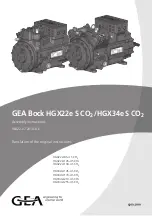
Shutting Down The Compressor
Do not turn the air compressor off by unplugging it from the mains
power as it may result in damage to the motor.
1. Turn the compressor off with the on/off switch and then unplug the
cord.
2. Rotate the pressure regulator
anti-clockwise until it is fully
closed; check the regulated
pressure gauge to ensure that
it reads 0psi.
3. Also turn on the air tool to
discharge any remaining
pressurised air in the air hose.
4. Remove the air hose and any
other connected accessories.
5. Slowly open the safety relief
valve to release any remaining
pressurised air.
6. When no more air is released,
open the drain valve to
release any accumulated
liquid from the tank.
7. Close the drain valve, allow the compressor to cool down, then
clean and store the unit.
5. TROUBLESHOOTING
Symptom
Possible Cause
Suggested Solution
The compressor
does not start
Compressor has
reached cut-out
pressure
Compressor will
automatically start once
below the cut-in pressure.
No power supply
Check the power supply,
the power plug and the
socket-outlet.
Insufficient supply
power
Reduce length of
extension lead.
Outside temperature
is too low
Never operate with an
outside temperature of
below 5
0
C.
Motor is overheated
Allow the motor to cool
down. If necessary,
remedy the cause of the
overheating.
Overloaded
Allow compressor to cool
down before restarting
the motor.
The compressor
starts but there is no
pressure
The seals are
damaged.
Check the seals and
have any damaged seals
replaced by a service
centre.
The drainage valve
leaks.
Ensure it is properly
closed.
The compressor
starts, pressure
is shown on the
pressure gauge, but
no pressure to the
air tool.
Loose hose
connections
Check the compressed
air hose and tools and
replace if necessary.
Leak in a quick-lock
coupling
Check the quick-lock
coupling and replace if
necessary.
Insufficient pressure
set on the pressure
regulator.
Open the pressure
regulator further.
0
50
100
150
200
225
0
50
100
150
200
225


































